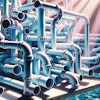I've always bought into the notion that to truly see where you're going, you have to understand where you've been. After all, moving forward without the benefit of hindsight means running the risk of repeating the mistakes of the past. At the same time, remaining stuck in the past and married to old habits means missing opportunities for change and innovation.
In this issue's edition of AQUA Architecture, you'll find examples of both. In my discussion titled Historic Hilltops, I chronicle my recent visits to historic aquatic sites with my longtime friend and frequent editorial collaborator, Dr. William N. Rowley. Without spoiling the details of those forays into history, I will say that the guiding principle in play is that Rowley's hard-won acumen in both history and contemporary design and engineering are utterly essential to the perpetuation of historic installations into the future.
It's only with that kind of deep understanding and in his case, vast experience, that it's possible to marry the work of past artisans with contemporary construction techniques, technology and materials. His ability to learn from the past and apply it to the present and future might be tricky for some, but in Rowley's case, it seems almost second nature.
I will also add that on those journeys described in the article, he demonstrated an almost giddy enthusiasm for participating in the history of these facilities. He's a modest guy who would never tout that unique set of skills and perspective, but instead relies on sound engineering practice with the occasional pithy observation such as, "The physics of water flowing through pipes doesn't care about history and never changes. It's up to us to make it work."
Appropriately, that story is presented alongside a wonderful discussion from another close friend and regular contributor, Mark Holden. In "Material Solutions," he describes how the design of an ultra-modern fountain located in the equally contemporary setting of Playa Vista, Calif., prompted him and the project team to turn to a relatively new type of material, known as fiberglass reinforced polymer, or FRP.
Mark is also a student, and teacher, of history. His classes on the vocabulary of art and architecture at industry events and in university classrooms, along with his frequent contributions to industry publications such as AQUA has informed and inspired many. Married with that expertise, he is also versed in technology, modern construction techniques and cutting edge materials science.
In the case of the project he describes in the following pages, we see an example of how achieving the design goals of the project design would have been virtually impossible had he and his colleagues relied strictly on traditional materials. As I worked with Mark to prepare the piece, he explained his belief that we all should be on the lookout for meaningful ways to change, but at the same time we should realize that there needs to be good reason for those changes.
In other words, change simply for the sake of change alone precludes the critical thinking and research needed to "boldly go" where no aquatic designer has gone before. I personally find it fascinating that although these two masters of aquatic arts and crafts are just about 40 years apart in age, they are both cut from similar bolts of cloth. Both share a restless fascination for the nuances of their work and a keen appreciation of marrying the experience of history with forward-thinking vision.
By example, they Rowley and Holden stand as living proof that balancing the lessons of the past while always facing the future is a quality that while rare is also genuinely timeless.
Comments or thoughts on this article? Please e-mail [email protected].







































